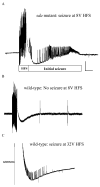From bench to drug: human seizure modeling using Drosophila
- PMID: 18063465
- PMCID: PMC2267866
- DOI: 10.1016/j.pneurobio.2007.10.006
From bench to drug: human seizure modeling using Drosophila
Abstract
Studies of human seizure disorders have revealed that susceptibility to seizures is greatly influenced by genetic factors. In addition to causing epilepsy, genetic factors can suppress seizures and epileptogenesis. Examination of seizure-suppressor genes is challenging in humans. However, such genes are readily identified and analyzed in a Drosophila animal model of epilepsy. In this article, the epilepsy phenotype of Drosophila seizure-sensitive mutants is reviewed. A novel class of genes called seizure-suppressors is described. Mutations defining suppressors revert the "epilepsy" phenotype of neurological mutants. We conclude this review with particular discussion of a seizure-suppressor gene encoding DNA topoisomerase I (top1). Mutations of top1 are especially effective at reverting the seizure-sensitive phenotype of Drosophila epilepsy mutants. In addition, an unexpected class of anti-epileptic drugs has been identified. These are DNA topoisomerase I inhibitors such as camptothecin and its derivatives; several candidates are comparable or perhaps better than traditional anti-epileptic drugs such as valproate at reducing seizures in Drosophila drug-feeding experiments.
Figures



Similar articles
-
DNA topoisomerase I inhibitors ameliorate seizure-like behaviors and paralysis in a Drosophila model of epilepsy.Neuroscience. 2008 Oct 15;156(3):722-8. doi: 10.1016/j.neuroscience.2008.07.024. Epub 2008 Jul 23. Neuroscience. 2008. PMID: 18703119 Free PMC article.
-
Seizure suppression by top1 mutations in Drosophila.J Neurosci. 2007 Mar 14;27(11):2927-37. doi: 10.1523/JNEUROSCI.3944-06.2007. J Neurosci. 2007. PMID: 17360915 Free PMC article.
-
Genetic suppression of seizure susceptibility in Drosophila.J Neurophysiol. 2001 Sep;86(3):1211-25. doi: 10.1152/jn.2001.86.3.1211. J Neurophysiol. 2001. PMID: 11535671
-
Seizure-suppressor genes: can they help spearhead the discovery of novel therapeutic targets for epilepsy?Expert Opin Ther Targets. 2023 Jul-Dec;27(8):657-664. doi: 10.1080/14728222.2023.2248375. Epub 2023 Aug 22. Expert Opin Ther Targets. 2023. PMID: 37589085 Free PMC article. Review.
-
Seizure and epilepsy: studies of seizure disorders in Drosophila.Int Rev Neurobiol. 2011;99:1-21. doi: 10.1016/B978-0-12-387003-2.00001-X. Int Rev Neurobiol. 2011. PMID: 21906534 Free PMC article. Review.
Cited by
-
Drosophila melanogaster as a model organism of brain diseases.Int J Mol Sci. 2009 Feb;10(2):407-440. doi: 10.3390/ijms10020407. Epub 2009 Feb 2. Int J Mol Sci. 2009. PMID: 19333415 Free PMC article. Review.
-
Identification of a novel synaptic protein, TMTC3, involved in periventricular nodular heterotopia with intellectual disability and epilepsy.Hum Mol Genet. 2017 Nov 1;26(21):4278-4289. doi: 10.1093/hmg/ddx316. Hum Mol Genet. 2017. PMID: 28973161 Free PMC article.
-
Ion channels to inactivate neurons in Drosophila.Front Mol Neurosci. 2009 Aug 28;2:13. doi: 10.3389/neuro.02.013.2009. eCollection 2009. Front Mol Neurosci. 2009. PMID: 19750193 Free PMC article.
-
Less is More: Reducing Tau Ameliorates Seizures in Epilepsy Models.Epilepsy Curr. 2013 Jul;13(4):184-5. doi: 10.5698/1535-7597-13.4.184. Epilepsy Curr. 2013. PMID: 24009485 Free PMC article. No abstract available.
-
Mutations of the Calcium Channel Gene cacophony Suppress Seizures in Drosophila.PLoS Genet. 2016 Jan 15;12(1):e1005784. doi: 10.1371/journal.pgen.1005784. eCollection 2016 Jan. PLoS Genet. 2016. PMID: 26771829 Free PMC article.
References
-
- Avoli M. Feline generalized penicillin epilepsy. Ital J Neurol Sci. 1995;16:79–82. - PubMed
-
- Baraban SC, Taylor MR, Castro PA, Baier H. Pentylenetetrazole induced changes in zebrafish behavior, neural activity and c-fos expression. Neuroscience. 2005;131:759–768. - PubMed
-
- Batini C, Teillet MA, Naquet R. An avian model of genetic reflex epilepsy. Arch Ital Biol. 2004;142:297–312. - PubMed
Publication types
MeSH terms
Substances
Grants and funding
LinkOut - more resources
Full Text Sources
Medical
Molecular Biology Databases
Research Materials

